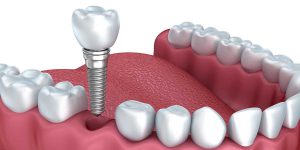(414) 301-5958
(414) 301-4137
Mon, Tue, Wed, Thu 9 AM to 2 PM by appointment/Closed: Fri, Sat, Sun
Dental Implants
Dental Implants
A natural tooth consists of a root and a crown. If you compare natural teeth to implant-supported replacement teeth, you’ll see they have the same basic parts. Both have a crown (the visible part used to chew food). Both have a root that holds the tooth securely under the gum and is anchored into the jaw. The difference is that the implant is made of titanium – the same time-tested material used by surgeons for artificial joints. When you lose a tooth, you lose both the root and the crown. To replace the tooth, the surgeon first replaces the root with a small dental implant.
Time is allowed for bone to heal and grow around the dental implant. The bone fuses with the titanium, creating a strong foundation for artificial teeth. A support post (abutment) is then placed on the implant and a new replacement tooth (crown) is placed by your general dentist on top of the abutment.
Dental implant surgery is, of course, surgery, and is best done by a trained surgeon. Your oral surgeon has the specialized education and training in the complexities of the bone, skin, muscles and nerves involved, to ensure you get the best possible results. A 2014 study suggests greater implant success rates when performed by a dental specialist.
The oral surgeons at White Oak use the most recent advances in dental implant technology to place your implants. Dental implant placement is a team effort between an oral and maxillofacial surgeon and a restorative dentist. The oral surgeons at White Oak perform the actual implant surgery, initial tooth extractions, and bone grafting if necessary. The restorative dentist (your dentist) fits and makes the permanent prosthesis. Your dentist will also make any temporary prosthesis needed during the implant process.

